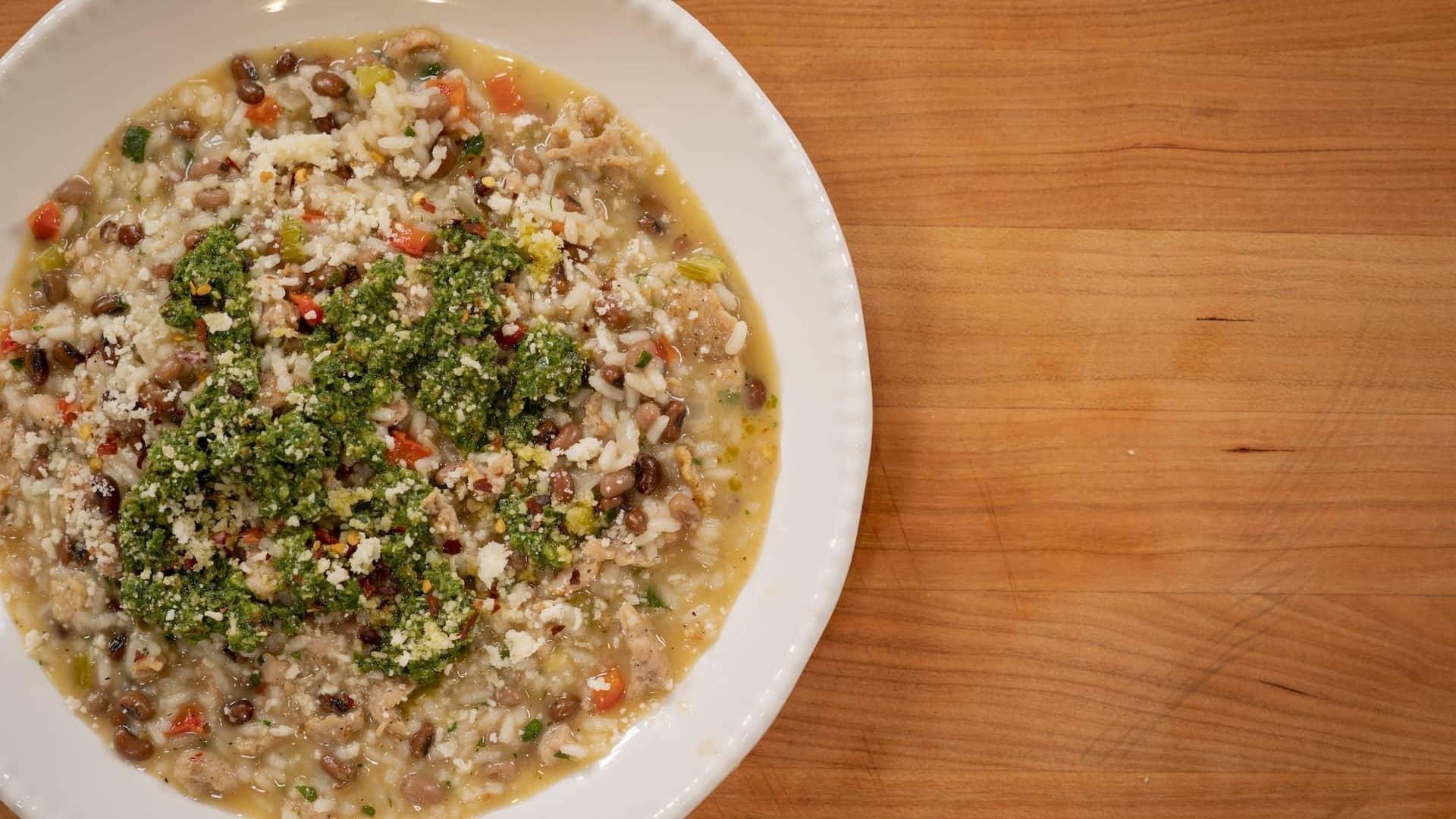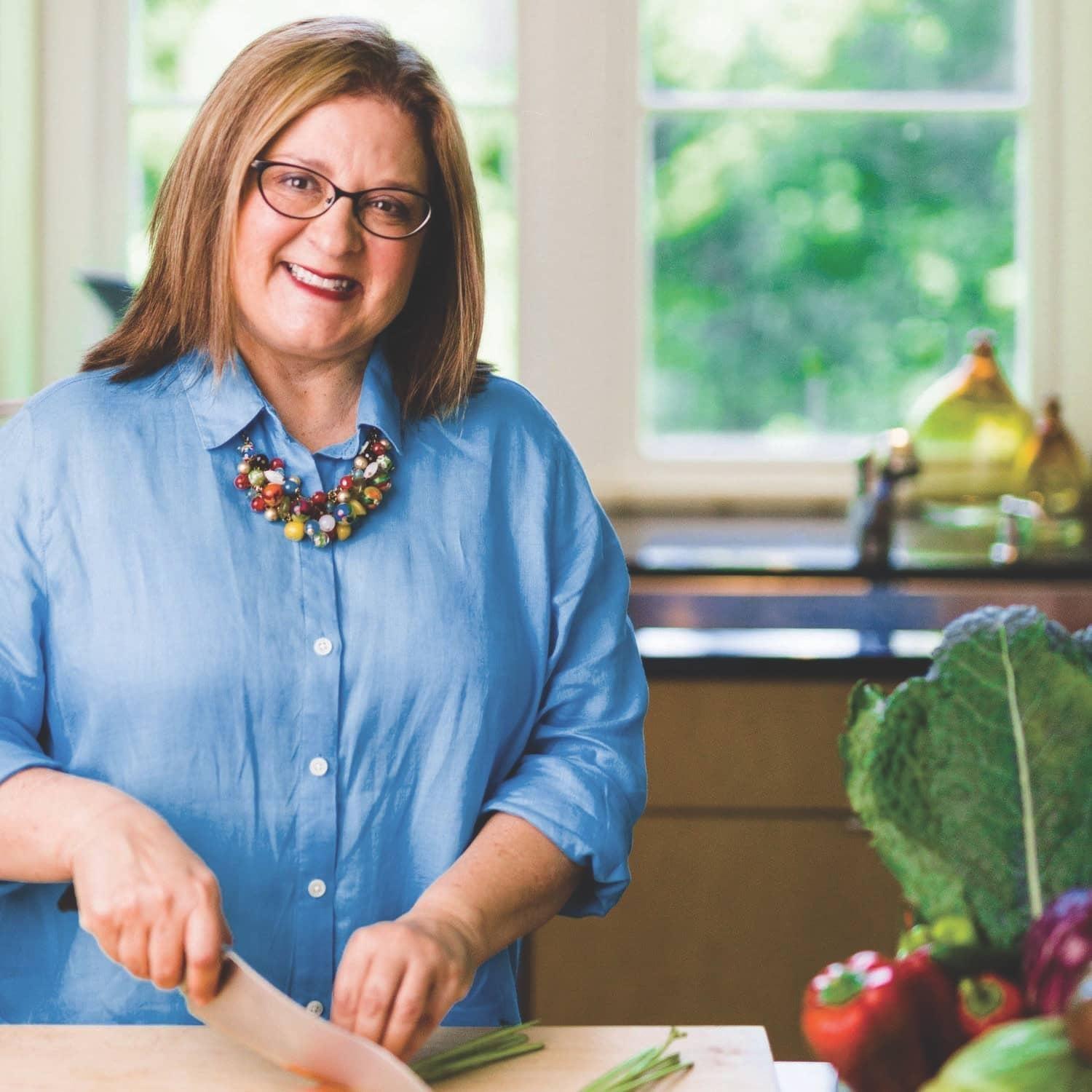
Hoppin’ John Risotto with Collard Pesto
Many folks believe that Hoppin’ John is always made with black-eyed peas, but that’s not true. It can be made with any of the dozens (hundreds?) of different types of delicious field peas. Sea Island Red Peas, which originated in West Africa, are the field pea first used in the dish that came to be known Hoppin’ John, for example. I encourage you to look for a type of field pea that grows well in your community, often found at local farmers’ markets. When local field peas are not an option, it’s fine to use fresh or frozen field peas from the grocery store.
I am deeply devoted to both Southern and Italian cuisines and am convinced they have the same soul. I often apply the techniques of one to the ingredients of the other. That explains why I make my Hoppin’ John—an iconic Southern dish—like risotto, creating a large pot of creamy rice and field peas studded with sausage. To continue the theme, I top each serving with a heaping spoonful of Collard Pesto. Don’t skip the Collard Pesto. It’s heavenly and it pulls the dish together.
Makes 8 servings.

Hoppin' John Risotto
- 1 1/2 cups shelled fresh or thawed field peas
- 1 teaspoon salt, plus more as needed
- 4 to 5 cups richly flavored chicken stock, preferably homemade
- 12 ounces sweet or hot Italian sausage
- 1 tablespoon olive oil, plus more as needed
- 1 cup chopped onion
- 1 cup chopped red bell pepper
- 1/2 cup chopped celery
- 1 1/2 cups Arborio, Carnaroli, or Carolina Gold rice (10 ounces)
- 1/2 cup dry white wine
- 1 tablespoon butter
- 2 tablespoons finely chopped flat-leaf parsley
- 1/4 cup finely grated Parmesan cheese, plus more for serving
- Kosher salt and ground black pepper, to taste
- Serve with: Collard Pesto (recipe follows – although you’ll want to make this first)
Rinse the peas under cool running water to remove any stickiness and loosen any bits of leaves and hulls. Pour into a medium-size saucepan, add the 1 teaspoon salt, and cover with water to a depth of 1 inch. Bring to a boil, skim away any foam, reduce the heat, partially cover, and simmer until tender, 15 to 25 minutes. The fresher and smaller the peas, the more quickly they will cook. Taste the peas. If they need more salt, stir in another 1 teaspoon and let stand (off heat) for 10 to 15 minutes, or until needed. Drain before using. (To cook the peas ahead, transfer them and the liquid to an airtight container and refrigerate for up to 5 days.) Drain just before using.
Bring the stock to a gentle simmer in a medium-size saucepan and keep warm over low heat.
Remove the casings from the sausage links. Break the meat into marble-sized pieces, like little meatballs. Heat the oil in a large skillet or wide saucepan over medium heat. Add the sausage and cook until the meat is no longer pink, about 10 minutes. Transfer with a slotted spoon to paper towels to drain. Pour off all but 2 tablespoons of the fat. (If you happen to have particularly lean sausage, add more olive oil to make up the difference.)
Warm the fat over medium-high heat. Stir in the onion, bell pepper, celery, and a pinch of salt. Cook until softened, stirring often, about 8 minutes. Add the rice and stir to coat each grain in the fat. Cook, stirring slowly and continuously, until the outside of each grain is shiny and translucent with a tiny white dot in the center, about 2 minutes. Stir in the wine and cook until it evaporates.
Reduce the heat to medium. Add 1 cup of the warm stock and cook, stirring slowly and steadily, until the rice absorbs the liquid. Continue adding stock 1/2 cup at a time, stirring all the while and letting the rice nearly absorb the stock before adding more. When done, the rice should be tender, yet a little firm in the center of each grain (like pasta al dente). The rice should be suspended in thick, creamy sauce. (Carolina Gold rice will be slightly less creamy.) You might not need all of the stock. The entire process should take about 25 minutes.
Remove the risotto from the heat and stir in the peas, sausage, butter, parsley, and cheese. Check the seasoning, although the sausage probably contains all the salt and pepper the risotto needs.
Serve at once, topped with a sprinkling of cheese and a generous spoonful of Collard Pesto.
Note: Fresh or frozen peas work best in this recipe, but when they are not available, you can use dried, which can be ordered online. Dried field peas should be soaked before cooking. Place them in a large bowl, cover with cool water to a depth of 2 inches, and let stand 12 to 24 hours to rehydrate. Alternatively, quick soak the peas by placing them in a saucepan, cover with cool water to a depth of 2 inches and bring to a boil. Let boil for 3 minutes, remove from the heat, and let stand for 1 to 2 hours or until plump and no longer wrinkly. The larger and older the dried peas, the longer they will need to soak. Drain and rinse the peas before cooking.
Collard Pesto
Although we often think of pesto as made only from basil, it comes in many forms, such as this delicious version made from leafy green collards. It’s perfect with the Hoppin’ John Risotto, but it can be served in any way you’d serve any other pesto. Collard pesto holds its vibrant color for days.
The collards should be small and tender, about the size of an outstretched hand. If the only collards you can find are larger, they must be extremely fresh with good color, pliant leaves, and clean edges. If you cannot find fresh collards of any size, use fresh Tuscan kale (aka black kale, dinosaur kale, or lacinato kale) instead. No type of frozen greens will work in this recipe.
Makes about 1 1/2 cups.
- 10 ounces small, tender, fresh collards
- 2 large garlic cloves
- 2 tablespoons chopped green olives
- 2 tablespoons chopped sundried tomatoes
- 1/4 cup chopped pecans, lightly toasted
- 1/4 cup grated Parmesan cheese
- 2 teaspoon sherry vinegar or lemon juice
- 6 to 8 tablespoons extra-virgin olive oil
- 1/2 teaspoon kosher salt, or to taste
- 1/4 teaspoon ground black pepper, or to taste
- Big pinch of cayenne pepper or crushed red pepper flakes
Strip the collard leaves off the stems and tough inner ribs. Coarsely chop the leaves; you should have about 5 lightly packed cups. Bring a large saucepan of salted water to a boil. Add the collards, reduce the heat, and simmer until tender, 10 to 15 minutes. Drain them in a colander and rinse under cold running water until cool. Drain well and transfer into the bowl of a food processor fitted with the metal blade.
Add the garlic, olives, tomatoes, pecans, cheese, and vinegar and pulse until finely chopped.
With the machine running, add the oil in a slow, steady stream. Process until the pesto is smooth and thick, which might take a couple of minutes.
Season with the salt, pepper, and cayenne. Serve at room temperature.
Make-Ahead: Store covered and refrigerated for up to one week. Return to room temperature and stir well before serving.
Hoppin' John Risotto with Collard Pesto | Kitchen Recipe
Sheri shares her savory Hoppin' John Risotto recipe with a Collard Pesto that is a keeper.

Recipe Courtesy of Sheri Castle
Sheri Castle, award-winning food writer and cooking teacher, is known for melding culinary expertise, storytelling and humor, so she can tell a tale while making a memorable meal. Her creative, well-crafted recipes and practical advice inspire people to cook with confidence and enthusiasm. She's written a tall stack of cookbooks and her work appears in dozens of magazines. In 2019, the Southern Foodways Alliance named Sheri among Twenty Living Legends of Southern Food, calling her The Storyteller.
Sheri says that she's fueled by great ingredients and the endless pursuit of intriguing stories, usually about the role that food plays in our lives, families, communities and culture.
When she steps away from the kitchen or a local farm, Sheri enjoys spending quiet time at her home near Chapel Hill. She hails from the Blue Ridge Mountains of North Carolina.
